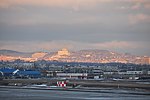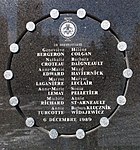The Montreal Laboratory in Montreal, Quebec, Canada, was established by the National Research Council of Canada during World War II to undertake nuclear research in collaboration with the United Kingdom, and to absorb some of the scientists and work of the Tube Alloys nuclear project in Britain. It became part of the Manhattan Project, and designed and built some of the world's first nuclear reactors.
After the Fall of France, some French scientists escaped to Britain with their stock of heavy water. They were temporarily installed in the Cavendish Laboratory at the University of Cambridge, where they worked on reactor design. The MAUD Committee was uncertain whether this was relevant to the main task of Tube Alloys, that of building an atomic bomb, although there remained a possibility that a reactor could be used to breed plutonium, which might be used in one. It therefore recommended that they be relocated to the United States, and co-located with the Manhattan Project's reactor effort. Due to American concerns about security (many of the scientists were foreign nationals) and patent claims by the French scientists and Imperial Chemical Industries (ICI), it was decided to relocate them to Canada instead.
The Canadian government agreed to the proposal, and the Montreal Laboratory was established in a house belonging to McGill University; it moved to permanent accommodation at the Université de Montréal in March 1943. The first eight laboratory staff arrived in Montreal at the end of 1942. These were Bertrand Goldschmidt and Pierre Auger from France, George Placzek from Czechoslovakia, S. G. Bauer from Switzerland, Friedrich Paneth and Hans von Halban from Austria, and R. E. Newell and F. R. Jackson from Britain. The Canadian contingent included George Volkoff, Bernice Weldon Sargent and George Laurence, and promising young Canadian scientists such as J. Carson Mark, Phil Wallace and Leo Yaffe.
Although Canada was a major source of uranium ore and heavy water, these were controlled by the Americans. Anglo-American cooperation broke down, denying the Montreal Laboratory scientists access to the materials they needed to build a reactor. In 1943, the Quebec Agreement merged Tube Alloys with the American Manhattan Project. The Americans agreed to help build the reactor. Scientists who were not British subjects left, and John Cockcroft became the new director of the Montreal Laboratory in May 1944. The Chalk River Laboratories opened in 1944, and the Montreal Laboratory was closed in July 1946. Two reactors were built at Chalk River. The small ZEEP went critical on 5 September 1945, and the larger NRX on 21 July 1947. NRX was for a time the most powerful research reactor in the world.





